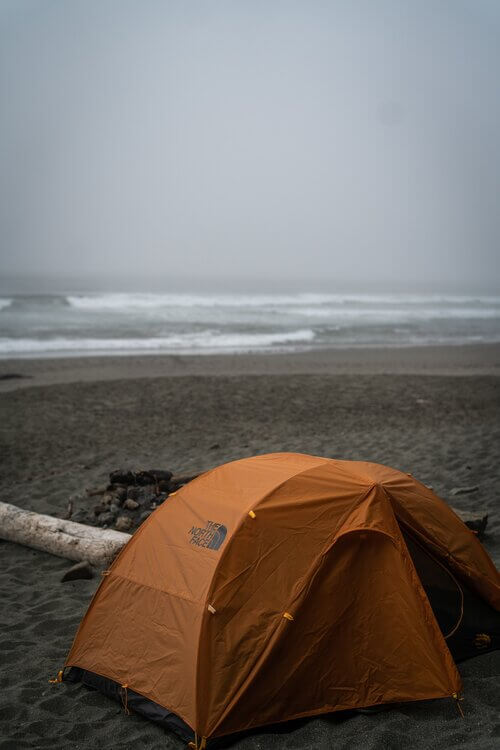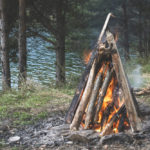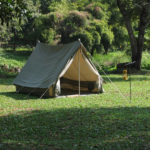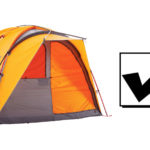Preparing for a camping trip can be somewhat challenging because there are many things to consider. One of the most important things, and one that you should do first when preparing for your trip, is checking the weather forecast. If wet weather is predicted for the weekend, you should consider postponing the trip until the weather improves.
Even if the forecast does not predict rain for the upcoming period, you should still prepare as if you expect to have a rainy trip. This is because the weather can be very unpredictable and take a turn for the worse in a matter of hours. So, before you head out on your camping trip, you must ensure you are prepared for anything and everything!
Considering how you will set up camp if it rains would be good. Setting a tent in the rain can be problematic, so I want to help you by telling you several things you should never forget. If you want to learn more on the topic, I recommend that you stick around for the rest of the guide!
More...

How to Set Up a Tent in the Rain? - 16 Tips & Tricks
Before you set off on a trip to the outdoors, you need to gather your tent and some rain gear that you could use to keep your tent dry in case of rain. There are a few things you need to do before leaving your home, so I will start with them and work my way towards telling you how to set up your tent in the rain. Let’s get right into the list and learn more on the topic:
1. Test your tent before going on the trip
Whether you have a brand new tent or one you have been using for a while, it is a good idea to test it before you set off on your trip. Even the best outdoor gear can sometimes suffer from wear and tear, so you will need to check and see if there are any tears on your tent.
If there are tears on the tent walls, you will need to take care of them so that rainwater will not be able to go through them to the inside of your tent.
2. Practice setting up the tent at home
When it rains outside, you must be very quick in setting your tent and tarp if you do not want to have everything soaked. So, I recommend you practice setting up your tent before going on your trip.
Practice everything – from setting up the rainfly to adding the ground tarp and setting your tent while keeping your gear dry in a different spot. Trust me, it will be worth it!
3. Get suitable waterproof covers
You will not stay dry during a rainy trip if you do not have suitable waterproof covers. It would be best if you also ensured that the covers are the right size for your tent. There are a few things to consider.
The rainfly or tarp needs to be at least twice the size of the tent, whereas the ground tarp should be larger than the tent. You can also get a waterproof biffy that comes in handy during rain trips.
4. Wait for the rain to stop
If you find it raining on your campsite when you arrive, wait for the rain to stop or slow down before you start setting up. If you are backpacking, try to find a dry spot to leave your gear. It could be under a tree or a cliff, so keep an eye out for such places.
If you are car camping, staying in your car and waiting for the rain to stop will be more convenient. Once it does, you can take out your things and start looking for the best spot where you can set your camp.
5. Find a suitable spot for your tent
If you expect rain or see it raining for a while, finding a spot to set your tent will be more challenging. The ground will likely be soaked, so you must inspect it before setting the tent up.
Look for trees with a larger crown that might have kept the ground dry. You can also look for a cliff or dense forest under which the land will not be as soaked. Remember to have trees around if you want to attach a rainfly or tarp.
6. Make sure there is good ground drainage
The spot you choose for your tent needs good ground drainage so that you will not have to deal with the wet ground for hours after it rains. The way to check if the ground has good drainage is by trying to put the tent stakes into it.
If you can put the tent stake into the ground without any problem, the soil should have good drainage. So, make sure that you check the type of soil before you set the tent and tarp.
7. Make an elevated tent spot
Wherever you set your tent, you need to ensure that it is at least a few inches above the rest of the ground. You can push some dirt under it or use larger rocks. Then, put the ground tarp and set the tent on it.
If you do all this, the tent bottom will not get soaked. You do not want rainwater to go under your tent and stay there for hours. This is likely to happen if there is a low spot under the tent.
8. Make an improvised shelter
If it is raining heavily and you need to protect yourself and your gear, I recommend that you make an improvised shelter from your rainfly or tarp. It is easy to get the guyline around it and attach it to trees.
The setup does not have to be perfect at this point – it should be good enough to keep you dry until the rain slows down. After the rain stops, you can reattach the tarp and set the tent under it.
9. Set a ground tarp first
To set the tent in the rain, you first need to set the ground tarp. The tarps are waterproof, so placing them on the soaked ground prevents the water from getting to your tent.
Some double-wall tents are waterproof and do not need a tarp underneath, but I still recommend using one to be on the safe side.
10. Try to set the tent during the day
If it is possible, set the tent up during daylight. It is way more challenging to set it up at night, whether it is raining or not. If you suspect it will rain well into the night, get the setup out of the way by doing it during the day. Also, attach the rain cover and keep it over your tent for as long as you need.
11. Get a rain tarp for the tent’s inside
You should consider adding an inner mesh tent if you suspect rain might get into your tent. Most double-wall tents have good waterproofing and will not allow water to get inside the tent. Still, you can add a lightweight tarp on the inside to prevent a watery disaster.
12. Wipe any water from the tent walls
Setting up the tarp before the tent is smart, but sometimes, you might not get enough time to set the tarp before the tent. If you start setting the tent in the rain and see that its walls are getting soaked as you are setting it, get a towel or something similar and wipe the water from the walls. Otherwise, you might find that the water makes its way into the tent.
13. Keep the tent sealed during the rain
When it is raining and you are trying to set up the tent, ensure you do not open any of its doors or windows. That will allow water to make its way into the tent, causing it to become soaked. So, keep the tent sealed as you set it and while it rains. Try not to place any wet gear into it, and do not enter the tent if you have damp equipment on you. Keep the wet things outside and the dry bags inside.
14. Use a waterproof bivouac sack
A waterproof bivouac sack or bivvy is something you can use with single-wall tents to keep them protected from the rain. This sack packs small. It is lightweight but durable, waterproof, and offers excellent insulation. I recommend getting one if you tend to camp with single-wall tents often.
15. Protect yourself and the tent from lightning
To protect yourself and all your gear from lightning and thunder, I recommend moving into a deep forest or standing under a cliff. It would be best if you were not standing under a single tree as lightning is likely to strike such trees. Take all your gear and place it in the safe spot as well.
16. Have good waterproof shoes
Good waterproof gear and shoes are always an excellent investment as they can help you stay protected during rainy trips. Do not put off getting such gear – do it as soon as possible, and you will be able to set camp even when it is raining without worrying about getting soaked.

How to Tarp a Tent for Rain?
To ensure your trip to the outdoors will be a success, you need to know how to set the tent and add a rain tarp. You can set the tent in a matter of minutes if the weather is good, but you should also spend a few extra minutes setting your tarp in case it rains. It is better to be prepared than to deal with the tarp once it starts to rain!
When on the market for a tarp, you should remember that it must be larger than the tent. It can be up to twice its size, as the larger size will help you keep your tent protected underneath the tarp. Also, ensure that the tarp is waterproof and durable enough to withstand even heavy rain.
Once you have your tarp, I recommend taking it on all your outdoor trips. To set your tarp above your tent, you will need a bit of guy line and some trees to tie the string around. So, when choosing a spot for your tent, also make sure there are trees around that you can use to set the tarp.
There should be small openings on all four ends of the tarp. Get the guy line through those ends and all around the tarp. Then, make knots to ensure the tarp will not be able to move once you set it up.
When you prepare all this, you can grab the guy lines and attach each one to a nearby tree. Ensure the tarp is stretched out so the water can slide right off it. As a final note, I recommend setting one end of the tarp higher than the other so that the water can slide right off that end.
That would be all about setting up the tarp. Once you have that, you can set the tent under it. It would be best if you put it near the middle of the tarp so no rain can get to it. You will also be able to keep any chairs, gear, or backpacks protected under the tarp, thanks to the extra space it gives you!
Wrap-Up
Thank you for sticking with me through this detailed guide on the best way to set up a tent in the rain. I hope you learned a lot of valuable information you can use on all upcoming trips. Always take your rain tarp and waterproof covers when preparing for an outdoor trip.
Do you know any other interesting ways to set up tents in the rain? Or do you know any other outdoor gear that can come in handy when camping in the rain? I would love to read everything you want to share with me about this topic, so do not hesitate to share your comments in the section below!
- Are Merrell Shoes Good? – An Unbiased Review of Merrell Footwear - December 9, 2023
- Where Are Merrell Shoes Made? - December 9, 2023
- Camping in 40-degree Weather: Tips and Tricks - September 25, 2023

![How to Dry Tent after Rain? – 2 Proven Methods [Explained] How to Dry Tent after Rain? – 2 Proven Methods [Explained]](https://grandcircletrails.com/wp-content/uploads/2021/08/How-to-Dry-Tent-after-Rain-1-150x150.jpg)




